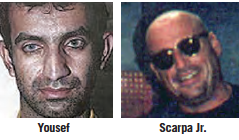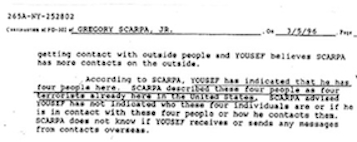Recent Posts
- Get HOMICIDE in four editions. Rated No.1 among The Five Best Crimes Biographies of All Time
- Peter Lance Biography
- HuffPost: DOJ report on MISSBURN case leaves out key detail: I.D. of the Mafia killer who broke the case for Hoover’s FBI
- On Halloween in 1994 CBS aired a new take on Orson Welles’ radio classic “War of The Worlds.” With 225,000+ views, it’s now become a YouTube cult favorite as well.
- Jason Leopold calls TRIPLE CROSS a “9/11 masterpiece”
Archives
- November 2025
- October 2025
- September 2025
- March 2025
- February 2025
- January 2025
- December 2024
- November 2024
- October 2024
- July 2024
- June 2024
- March 2024
- January 2024
- November 2023
- June 2023
- March 2023
- February 2023
- December 2022
- August 2022
- July 2022
- March 2022
- February 2022
- January 2022
- December 2021
- August 2020
- July 2020
- June 2020
- February 2020
- January 2020
- November 2019
- September 2019
- April 2019
- February 2018
- January 2018
- December 2017
- November 2017
- September 2017
- June 2017
- April 2017
- February 2017
- January 2017
- December 2016
- November 2016
- October 2016
- September 2016
- August 2016
- July 2016
- June 2016
- May 2016
- April 2016
- March 2016
- February 2016
- January 2016
- December 2015
- November 2015
- October 2015
- September 2015
- August 2015
- July 2015
- June 2015
- May 2015
- March 2015
- February 2015
- January 2015
- December 2014
- November 2014
- July 2014
- June 2014
- May 2014
- April 2014
- March 2014
- January 2014
- December 2013
- November 2013
- October 2013
- September 2013
- August 2013
- July 2013
- June 2013
- May 2013
- April 2013
- March 2013
- February 2013
- January 2013
- December 2012
- November 2012
- October 2012
- September 2012
- August 2012
- July 2012
- June 2012
- May 2012
- April 2012
- January 2012
- December 2011
- June 2011
- April 2011
- March 2011
- February 2011
- January 2011
- November 2010
- October 2010
- March 2010
- August 2009
- November 2006
- November 2004
- October 2003
- September 2003
- February 2000
Categories
- 1000 Years for Revenge
- ABC's Path to 9/11 issue
- Ali Mohamed
- Ali Mohamed revelations
- Anwar al-Awlaki
- ARCHIVES
- awards
- bio
- BIOGRAPHY
- BOOK TV C-SPAN2
- BOOK WRITING
- BOOKS
- Colombo family "war"
- Commentary
- DUI investigation
- Emad Salem investigation
- FBI ORGANIZED CRIME
- Featured
- FICTION
- First Degree Burn
- Fitzgerald censorship attempt
- Fitzgerald censorship scandal
- Fox News
- Gotham City Insider
- Gregory Scarpa Jr.
- Gregory Scarpa Jr.
- Gregory Scarpa Sr.
- Harpercollins
- HUFFINGTON POST
- INVESTIGATIONS
- Khalid Shaikh Mohammed
- MAGAZINE ARTICLES
- Major Hasan Fort Hood massacre
- MEDIA COVERAGE
- Meier Kahane Assassination
- Meir Kahane assassination
- Murder Inc.
- Nat Geo whitewash
- NEWSPAPER REPORTING
- NOVELS
- Oklahoma City bombing
- Omar Abdel Rahman
- OPERATION ABLE DANGER
- POLICE CORRUPTION
- Produced
- R. Lindley DeVecchio
- Ramzi Yousef
- Ramzi Yousef sting 302's
- REPORTING & ANALYSIS
- RESEARCH
- Santa Barbara News-Press
- SCREENWRITING
- Stranger 456
- Stranger 456
- teleplays
- Tenacity Media
- Triple Cross
- Triple Cross
- TV NEWS COMMENTARY
- Uncategorized
- videos
- WIKIPEDIA
Treasure trove of FBI 302s from the FBI sting of Ramzi Yousef by Gregory Scarpa Jr. in federal jail
CLICK HERE for a page with a number of the 302s documenting the sting
CLICK HERE for Peter Lance’s PLAYBOY article on the sting: “The Chilling Effect.”
A MAFIA WISEGUY UNCOVERS A TREASURE TROVE OF AL QAEDA INTEL
 The 9/11 Commission Report, published in July 2004 and later nominated for a National Book Award, concluded that the original World Trade Center bombing cell was made up of a “loosely based group of Sunni Islamists”; further, that the 9/11 plot had originated not with Ramzi Yousef in Manila in 1994, as I had demonstrated, but with Yousef’s uncle Khalid Shaikh Mohammed, who—according to Snell’s account—merely pitched the planes-as-missiles operation to Osama bin Laden in 1996.
The 9/11 Commission Report, published in July 2004 and later nominated for a National Book Award, concluded that the original World Trade Center bombing cell was made up of a “loosely based group of Sunni Islamists”; further, that the 9/11 plot had originated not with Ramzi Yousef in Manila in 1994, as I had demonstrated, but with Yousef’s uncle Khalid Shaikh Mohammed, who—according to Snell’s account—merely pitched the planes-as-missiles operation to Osama bin Laden in 1996.
The evidence I’d obtained from the Philippines National Police demonstrated that the Yousef-KSM Manila cell was funded directly by bin Laden via his brother-in-law, but the Commission, with the backing of Snell and other ex-Feds, concluded that KSM wasn’t even a member of al Qaeda in 1996. By mid-2004 I was getting closer to the truth. The 1996 FBI 302 memos I’d tried to share with the commission showed that the Bureau, and prosecutors from the Justice Department, had affirmatively covered up evidence of an active al Qaeda cell in New York City.
The same intelligence revealed the existence of a bin Laden-sponsored plot to hijack U.S. airliners, designed to pressure the U.S. to free the blind Sheikh and Ramzi Yousef, who was locked up in the Metropolitan Correctional Center (MCC) in Lower Manhattan. Similar threat reporting would show up in Presidential Daily Briefings in 1998 and 2001—a fact that later made headlines—but my findings revealed that the FBI had buried identical intelligence years before. Why would America’s most elite law enforcement and investigative agencies suppress such critical intel?
Their motive could be traced to a most surprising quarter: organized crime. As a phone book-sized file of documentary evidence from prosecutors in the Eastern District of New York reveals FBI investigators and federal prosecutors were desperate to avoid a scandal over an alleged corrupt relationship between R. Lindley DeVecchio, a senior supervisory special agent in the Bureau’s New York Office, (NYO) and a notorious hit man named Gregory Scarpa Sr., whose two-year war of succession in the Colombo crime family had left twelve people dead, including two innocent bystanders.
Through a bizarre turn of events, the Yousef evidence came from the killer’s son, Greg Scarpa Jr., a junior wiseguy who happened to inhabit a jail cell adjacent to Yousef’s at the MCC. But rather than risk losing a series of sixty Mafia cases in the Eastern District built on tainted evidence from Scarpa Sr., the Feds decided to bury the intel.
One of the lead prosecutors who disconnected those dots, I learned, was Patrick Fitzgerald, then the head of Organized Crime and Terrorism in New York’s Southern District. Considered the Justice Department’s leading authority on bin Laden, Fitzgerald would go on to become U.S. Attorney in Chicago, and special prosecutor in he ongoing investigation of media leaks regarding former CIA operative Valerie Plame, which ultimately cleared White House aide Karl Rove, while indicting Lewis “Scooter” Libby, top aide to Vice President Cheney.
AL QAEDA MEETS THE MOB
Much of this tangled tale was laid out in great detail in my second investigative book Cover Up, published in September of 2004. It documented an ends/means decision by senior FBI and Justice Department officials to suppress the DeVecchio scandal, preserve those mob cases, and brand the Yousef-Scarpa Jr. intelligence a “hoax” and a “scam.”
 Until the cover up, that intelligence—chronicled in dozens of FBI 302s and notes from Yousef—was considered so important to the Feds that they gave Scarpa Jr. a camera to photograph it and even set up a phony Mafia front company, the “Roma Corporation,” allowing them to monitor Yousef’s outside calls.
Until the cover up, that intelligence—chronicled in dozens of FBI 302s and notes from Yousef—was considered so important to the Feds that they gave Scarpa Jr. a camera to photograph it and even set up a phony Mafia front company, the “Roma Corporation,” allowing them to monitor Yousef’s outside calls.
By the fall of 1996, the Bureau’s internal affairs probe on DeVecchio was closed and Yousef was convicted along with Murad and a third conspirator. Dietrich Snell and Mike Garcia, the current U.S. Attorney for the SDNY, had won a decisive victory\and the Feds soon began to believe that they were winning the war against al Qaeda. But the burial of that evidence, which prevented other U.S. intelligence agencies from appreciating al Qaeda’s true breadth and depth, would have shocking repercussions.
As I looked back on the Justice Department’s counter-terrorism track record, I concluded that many of the dots left unconnected by the FBI and DOJ on the road to 9/11 appeared to have been the result of an intentional obscuring of the evidence.
Continuing to work sources and examine the reams of documentary evidence generated in the SDNY al Qaeda cases, I came to the conclusion that the FBI’s failure to prevent the African embassy bombings in 1998, the deadly assault on U.S.S. Cole in 2000, and the 9/11 attacks themselves, went beyond gross negligence. It seemed as if a number of FBI officials and federal prosecutors at the heart of the bin Laden hunt realized that they had been outgunned for years. So they had acted affirmatively to partition the intelligence.
I believe that their motive was to sanitize the record and thus prevent the public from understanding the full depth of the FBI/DOJ missteps in the years leading up to September 11. So “walls” were intentionally built, and key intelligence was withheld from other agencies, including the CIA and DIA. In any other government enterprise, the consequences might have been more benign. but in the realm of national security that compartmentalization of intelligence proved fatal.
By the third anniversary of 9/11, the Scarpa-Yousef evidence had been published in Cover Up. Sixteen months later, DeVecchio would finally be arraigned on murder charges stemming, in part, from that investigation. But many unanswered questions remained. I wanted to know the names of the men and women in the shadows at Justice who had suppressed the evidence and hidden the truth behind al Qaeda all those years. I also wanted to learn why the Bush 43 Administration would act to obstruct an investigation into the destruction of the Able Danger intel, a scandal that took place during the Clinton years?
It took me months of further digging before the depth of the government’s deception started to become clear.



Recent Comments